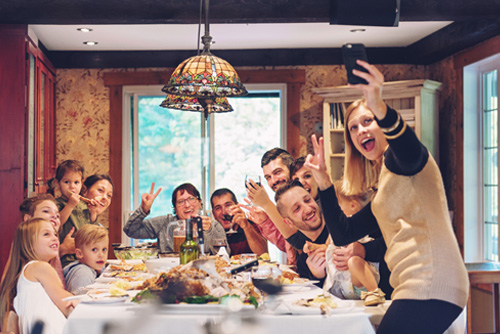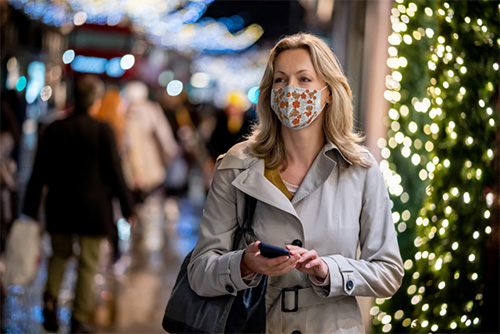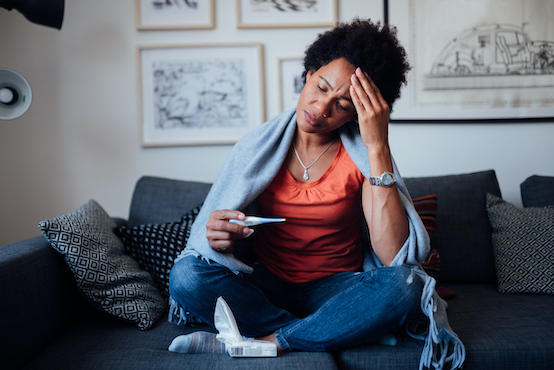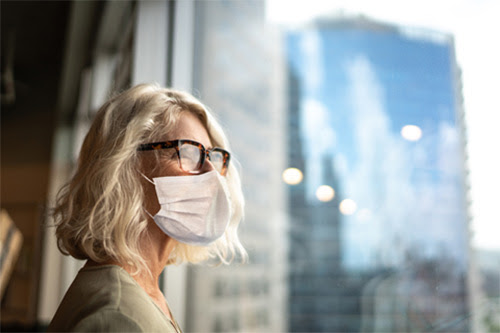Reviewed by Dr. Sarika Arora, MD
Ready for normal life again?
After last year’s socially distanced holiday season, 2021 is all about the return of in-person gatherings. Are you hosting a crowd for the holidays — or visiting family for the first time in a long time?

The CDC’s Covid-19 guidance for planning safe holiday get-togethers is cut and dry. Get vaccinated. Keep indoor gatherings ventilated. Wear a mask if needed. Obvious — but not really helpful.
Let’s talk frankly about the difficult choices you have to make. For example:
- Will your gathering put unvaccinated younger children beside older family members?
- Is a distant relative with unknown vaccine status coming over?
- When’s the last time your college student got a Covid test?
- Is your family polarized about the calculation of Covid safety and risk?
With so many possible variables to juggle, figuring out how to keep holiday gatherings safe requires a little more nuance. So, here are a few practical Covid guidelines you can fit to your family’s health needs.
Rule #1: Transparency
In WHN’s view, most people have actually done a decent job assessing their personal risks and what to do about it. Not everyone, of course, but most. The core controversy is about the risks their choices create for other people.
The implication is clear: to let your guests make their own risk assessments, be transparent about everyone else’s status and choices.
And that goes for you too!
Rule #2: The host can set ground rules
In poker the dealer gets to call the game. The same is true when you’re hosting.
If you want to set minimum requirements, go right ahead. Is it important to you that everyone who can be vaccinated is? Are you comfortable welcoming guests who have recovered from Covid, but have not had their shots? (You should be!) Would you feel better if unvaccinated guests sent you a recent negative PCR test before coming over? Do you want people to prove their status?
Keep in mind the nightmare scenario — your holiday gathering turns out to be regrettable, because someone gets Covid and suffers the consequences — or, heaven forbid, dies.
This doesn’t mean any gathering can be 100% risk-free. Life isn’t risk-free. But risks should be managed and everyone’s choices should be based on transparent knowledge of the risks.
Rule #3: Think outside the box
Here’s a crazy idea: do something different this year. If one faction in your family is unvaxxed and another faction feels afraid of Covid risks…try separating them. If you don’t have room in your house to do that, can the family manage two venues near one another? Remember, contact is not actually risky…Covid is spread through the air. So the key risk is being in a confined space, and the risk increases with time together.
Let’s do an example — we’ll call it the Rockwell Family.
The Rockwell Family Scenario
Normally all 15 Rockwells gather around the dining room table at the oldest daughter’s house. There are 4 households altogether. One is the grandparents, both of whom are fully vaccinated but high-risk due to age and chronic conditions. Second is the oldest’s: he and his wife are unvaccinated but have had Covid; their kids live away from home, are older, unvaccinated and probably uninfected too; one of them will bring his new girlfriend, whose status is unknown. Third is Ruthie’s, the host. Everyone in her family is vaccinated, but her youngest child is immunocompromised. Fourth is the younger daughter’s. She and her husband and older child are vaccinated, but not their younger one, who only recently became eligible.
Ruthie feels strongly about protecting the three immunocompromised family members, even though they are all vaccinated. After a little negotiation, here are the rules that she communicates to everyone:
- Those who are unvaxxed and without prior (documented) Covid infection have to take a PCR test within 48 hours of visiting.
- Everyone, even those who are vaccinated, will have to take a “rapid test” on arrival, which Ruthie will provide.
- No masks are required for the event, but hugging is optional and the windows will be opened in the TV room because of all the shouting during football games.
Ruthie’s big worry is that the unvaxxed will be infectious though asymptomatic, so she wants to be doubly sure they don’t infect the three family members who are immunocompromised. This is a cautious approach but not unrealistic given recent evidence about asymptomatic community spread. And she would rather do the extra testing than require people to wear masks around the house. She lets the immunocompromised make that decision for themselves, not for others. She tells everyone the rules and they all agree to attend.
PCR and “rapid” Covid tests
We all know about PCR tests for Covid — they are considered the gold standard, and for good reason. They’re expensive but very accurate, with low incidence of false negatives or positives. Those who are unvaccinated have become used to being forced to pay for them — a kind of penalty for their vaccine hesitancy. There’s no reason not to use them in the context of a holiday gathering. The one drawback of PCR tests is that you must wait 1-3 days (and longer, in some areas) for results. There’s a small risk that someone who didn’t technically have Covid three days before the holidays will actually be infectious during the gathering itself.
That’s where “rapid” tests come in. They’re inexpensive and quick: you can self-administer the test and see the results in 15 minutes. The downside is that they often yield false positives and negatives. That’s why in a “mixed risk” gathering it’s safer to have the riskiest “vectors” (the people most likely to be infectious) take a PCR test 2-3 days before the event, plus a rapid test on-site. When administered to a person who is vaccinated, the odds that that person is a vector due to a breakthrough but symptomless infection become nearly zero.
Create a healthy microenvironment
Good hygienic practices are smart with every gathering, but especially when some of your guests are immunocompromised (about half of Americans are, by our estimate) and you are hosting a “mixed vector” gathering. (“Mixed vector” means that some of your guests are higher-risk than others as a source of infection.)
SARS-CoV-2 spreads via airborne particles and droplets released by infected people during exhalation. Speaking, singing, exercise, coughing, sneezing and even the simple act of breathing quietly can all propel viral spread.
To reduce the risk of transmission, the CDC recommends opening windows and doors during indoor gatherings and placing a fan in the window to blow air out and encourage fresh air circulation. Many of us have purchased room air cleaners with HEPA filters, which remove viral particles. This is all good advice.
As an added tip, be careful about who has access to rooms in your home that are closed off without much air circulation, e.g., bathrooms, your basement family room, and walk-in closets and pantries. If you have a mix of some immunocompromised adults and unvaxxed kids coming over, consider designating one bathroom for kids and another for adults to reduce transmission risks (airborne particles can linger in the air for several minutes). If after dinner everyone usually heads to the basement den to watch football on the big screen, consider hauling the TV upstairs into more well-ventilated space for the day.
If your space just doesn’t provide for much air flow, spread out a little more to distance or ask everyone to wear masks before and after sitting down to eat. At-risk adults may wish to consider wearing a mask in any indoor or outdoor setting. Place a box of masks in an obvious spot so anyone who would like to wear one has access.
Serve a side dish of Swiss cheese
Almost two years into Covid we know there are five basic layers to lowering risk: vaccination or prior infection, testing, masking, ventilation and distancing. You can kind of toggle them back and forth, depending on your risk tolerance and the situation. We’ve compared this before to layers of Swiss cheese. Each slice has some holes in it, but when you start to layer them together, there’s no way through for the virus.
So, how about Swiss cheese for your next holiday party this year? Decide how many layers you need given your family and friends’ health needs. Do it with transparency so everyone feels comfortable with their own risks.
Then relax and enjoy the holidays! Thanksgiving is a time to give thanks and this year we can all be extra grateful that we’re alive and can gather once again.










